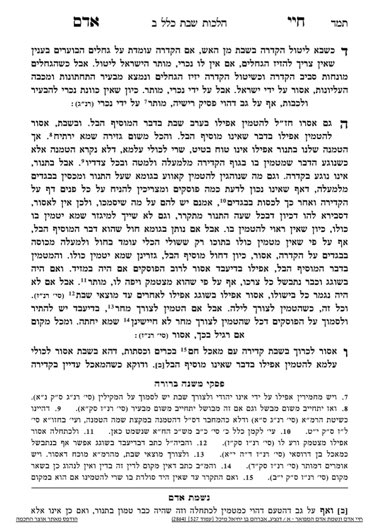We are continuing in siman 5, discussing the halachos of hatmana. The Chayei Adam writes that the definition of hatmana is when the insulating material touches the pot which is being insulated, and that it is surrounded on all sides. The reason Chazal prohibited hatmana was because they were concerned that a person is interested in heat and may therefore come to stir the coals. If the pot is not fully surrounded, it is clear they are not concerned about the heat so Chazal were not concerned the person will forget about Shabbos and rake the coals. However, if it is fully insulated on all sides, we have the concern that the next step will be for the person to rake the coals.
If so, hatmana b’miktzas, where the pot is not fully insulated, should be muttar. This is the opinion of the Rema and seems to be the clear implication of the Chayei Adam, who defined hatmana as insulating the pot on all sides. However, the Shulchan Aruch holds that hatmana b’miktzas still has the status of hatmana if the insulating material is mosif hevel.
We learned (S0048) that there is no issue of hatmana in an oven, because the oven walls do not touch the food. Their ovens were shaped like a cone, in that they were larger on the bottom and smaller on the top. The bottom was open and attached to the ground, using the ground as the floor of the oven. The top was open with a much smaller hole in order to allow for smoke to escape. There would be an opening on the side as well, in order to insert the food.
Since the bottom of the oven was dirt, even when they would remove the coals, the dirt was still warm, and was an ideal place for keeping food warm. Therefore, they would prepare coffee, dig a small hole in the floor of the oven, and keep it inside in order to keep their coffee warm. The oven functions as a mosif hevel, because even after the coals have been removed, there is a tremendous amount of heat in the oven. Nevertheless, the Chayei Adam writes that our minhag is to allow such a scenario, for two reasons. One, there is not full hatmana, as the hole in the ground did not fully surround the coffee pot. This was both because the hole did not fit snugly around the pot, and because the pot was not fully buried inside. Two, the argument could be made that the oven does not have the halachic status of mosif hevel without the coals, as it itself does not add heat. The heat was from the fire which has been removed. If so, it is a maamid hevel, and it is muttar to perform hatmana with a maamid hevel as long as it is done before Shabbos.
Even if one were to cover the coffee pot with clothing, such that it is now insulated on all sides, the second argument, that it is only a maamid hevel, will still make it that there is no issue of hatmana.
The Chayei Adam concludes that not all poskim agree that an oven if a maamid hevel. Some poskim are machmir to consider an oven a mosif hevel, and we are concerned for hatmana when the coffee is fully insulated on all sides. However, the Chayei Adam concludes that one can rely on an oven being a maamid hevel, and it is muttar to put the coffee in the dirt from erev Shabbos.
Summary
- A davar mosif hevel cannot be used for hatmana even before Shabbos
- A davar maamid hevel can be used for hatmana before Shabbos, but not on Shabbos itself.
- Hatmana is defined as when the insulating item directly touches the pot and fully covers the pot. If these two conditions are not present, it is considered hatmana b’miktzas, and is muttar for Ashkenazim. Sephardim are still machmir if the insulating material is mosif hevel.
- Placing food in a warm oven (without any heat source present) is not considered hatmana, since the oven walls do not directly touch the pot.



